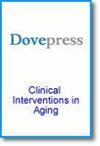Association Between Barthel’s Index Change and All-Cause Mortality Among COVID-19 Pneumonia Patients Aged Over 80 Years Old: A Retrospective Cohort Study
IF 3.7
3区 医学
引用次数: 0
Abstract
Purpose: It has been shown that lower Barthel’s index (BI) at admission is associated with a higher in-hospital mortality. There is a lack of evidence regarding the association between the change in BI during hospitalization and mortality after discharge. Our purpose was to determine whether the BI change during hospitalization is associated with all-cause mortality in older adults with COVID-19 pneumonia.Patients and Methods: We conducted a retrospective cohort study of 330 participants at Peking University Third Hospital during the COVID-19 pandemic period. In order to analyze the time to death data, a Kaplan-Meier survival curve was used. We used restricted cubic splines to analyze the association between BI change and all-cause mortality among COVID-19 pneumonia patients aged over 80 years old. Threshold effect analysis was used to assess the ability of BI change score to predict all-cause mortality.
Results: Our study included 330 patients aged over 80 years with COVID-19 pneumonia. The Kaplan-Meier curve for mortality showed significantly worst survival with reduced BI among three groups (χ2= 6.896, P < 0.05). There was a non-linear association between the BI change and all-cause mortality (P for all over < 0.001). The effect sizes on the left and right sides of the inflection point were 0.958 (HR: 0.958, 95% CI 0.932– 0.958, P < 0.05) and 1.013 (HR: 1.013, 95% CI 0.967– 1.062, P > 0.05), respectively.
Conclusion: Reduced BI during hospitalization was associated with the highest mortality risk. It is crucial to monitor BI change among COVID-19 pneumonia patients aged over 80 years old.
Keywords: COVID-19 pneumonia, activities of daily living, mortality, older adult
COVID-19 80 岁以上肺炎患者的巴特尔指数变化与全因死亡率之间的关系:回顾性队列研究
目的:研究表明,入院时较低的巴特尔指数(BI)与较高的院内死亡率有关。关于住院期间 BI 变化与出院后死亡率之间的关系,目前还缺乏相关证据。我们的目的是确定在患有 COVID-19 肺炎的老年人中,住院期间 BI 的变化是否与全因死亡率有关:我们对 COVID-19 大流行期间北京大学第三医院的 330 名患者进行了回顾性队列研究。为了分析死亡时间数据,我们使用了 Kaplan-Meier 生存曲线。我们使用限制性三次样条曲线分析了 COVID-19 肺炎 80 岁以上患者中 BI 变化与全因死亡率之间的关系。阈值效应分析用于评估 BI 变化评分预测全因死亡率的能力:我们的研究纳入了 330 名 80 岁以上的 COVID-19 肺炎患者。死亡率的 Kaplan-Meier 曲线显示,在三组患者中,BI 降低的患者生存率明显最差(χ2= 6.896,P <0.05)。BI 变化与全因死亡率之间存在非线性关联(P 均大于 <0.001)。拐点左右两侧的效应大小分别为0.958(HR:0.958,95% CI 0.932-0.958,P <;0.05)和1.013(HR:1.013,95% CI 0.967-1.062,P >;0.05):结论:住院期间 BI 降低与最高的死亡风险相关。结论:住院期间 BI 降低与最高死亡风险相关,监测 80 岁以上 COVID-19 肺炎患者的 BI 变化至关重要:COVID-19肺炎 日常生活活动 死亡率 老年人
本文章由计算机程序翻译,如有差异,请以英文原文为准。
求助全文
约1分钟内获得全文
求助全文
来源期刊

Clinical Interventions in Aging
GERIATRICS & GERONTOLOGY-
CiteScore
6.20
自引率
2.80%
发文量
193
期刊介绍:
Clinical Interventions in Aging, is an online, peer reviewed, open access journal focusing on concise rapid reporting of original research and reviews in aging. Special attention will be given to papers reporting on actual or potential clinical applications leading to improved prevention or treatment of disease or a greater understanding of pathological processes that result from maladaptive changes in the body associated with aging. This journal is directed at a wide array of scientists, engineers, pharmacists, pharmacologists and clinical specialists wishing to maintain an up to date knowledge of this exciting and emerging field.
 求助内容:
求助内容: 应助结果提醒方式:
应助结果提醒方式:


